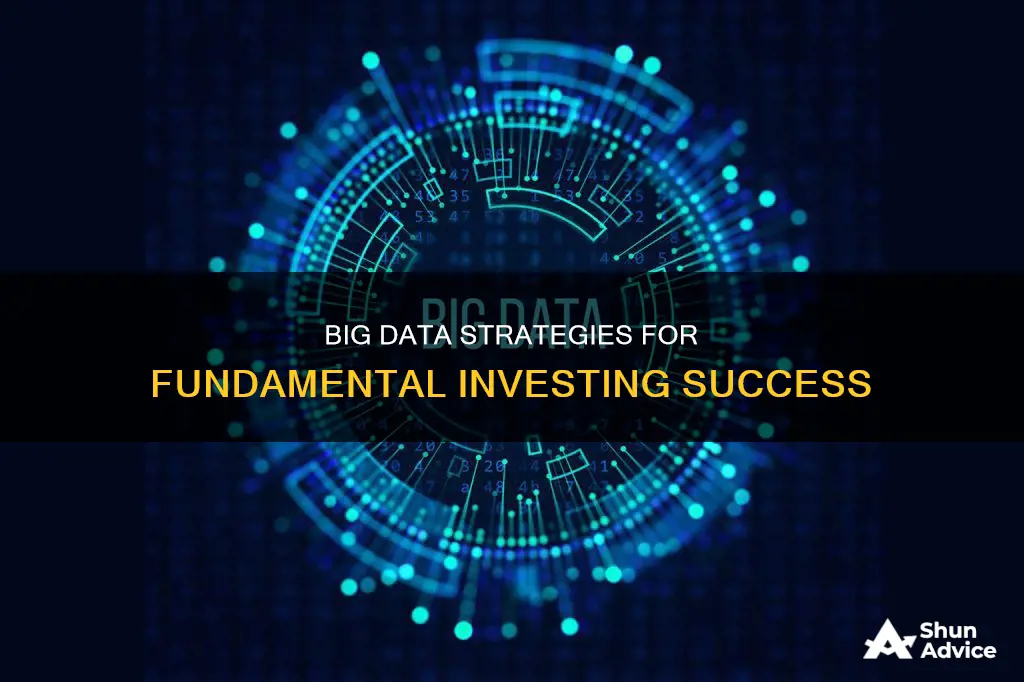
Big data is being used across a variety of industries, including financial services, to inform better business decisions. In the context of fundamental investing, big data can be used to improve the timing of stock picking. For example, news and social media sentiment data can be leveraged to make more accurate predictions about stock performance. This is especially true in the biotech sector, where news stories about patent grants, clinical trials, and drug pricing can be used to create a product-pipeline sentiment index that tracks the relative price-to-free cash flow multiple in the industry. Additionally, machine learning techniques can be used to support existing investment processes and improve overall productivity.
| Characteristics | Values |
|---|---|
| Volume | 2.5 quintillion bytes of data are created daily |
| Variety | Unstructured and structured data |
| Veracity | Data must be actively managed to inform business decisions |
| Velocity | The speed at which data is stored and analysed |
| Social media sentiment | Can be used to improve the timing of stock picking |
| News sentiment | Can be used to predict stock performance |
| Product pipeline | News events related to upcoming drugs can be used to create a product-pipeline sentiment index |
| Patent news | Stocks with positive patent news tend to outperform their industry in the following year |
| FDA priority review | Stocks with news of FDA priority review tend to outperform in the following year |
| Product releases | Stocks with successful new product launches tend to outperform |
| Product pricing | Being in the news due to big price increases is a counterproductive strategy for equity returns |
What You'll Learn

News and social media sentiment for stock picking
News and social media sentiment analysis is an increasingly important tool for stock picking and investment decisions. The vast amount of data generated daily, including news articles and social media posts, can be leveraged to gain valuable insights and make informed choices. Here's how news and social media sentiment analysis can be used for stock picking:
Data Collection and Analysis:
- News and social media platforms are rich sources of information, with news articles providing in-depth analysis and social media offering a platform for public opinion and sentiment expression. Data collection involves gathering news articles, social media posts, and historical stock data related to specific companies or industries.
- Sentiment analysis techniques are then applied to this data to determine whether the overall sentiment is positive, negative, or neutral. This involves classifying text as positive, negative, or neutral, which can be done using machine learning algorithms.
- The sentiment analysis results are combined with historical stock data to identify patterns and correlations between sentiment and stock price movements. This helps in understanding the impact of news and social media sentiment on stock prices.
Enhancing Investment Decisions:
- News and social media sentiment analysis can provide early indicators of stock price movements by capturing public sentiment and market trends. For example, positive news about a company's financial results or new product launches can lead to increased investor optimism and potentially drive up stock prices.
- By analyzing sentiment over time, investors can identify trends and make more informed decisions. For instance, if sentiment for a particular stock has been predominantly positive for an extended period, it may indicate a sustained upward trend in the stock price.
- Sentiment analysis can also help identify potential red flags or negative sentiment that could impact a company's reputation and stock performance. This allows investors to make more cautious decisions or adjust their investment strategies accordingly.
- Additionally, news and social media sentiment can be combined with other quantitative and qualitative factors, such as financial ratios, industry trends, and management effectiveness, to make more comprehensive investment decisions.
Applications and Benefits:
- News and social media sentiment analysis has been found to be particularly useful in the biotech and pharmaceutical industries, where news about product pipelines, patent grants, and regulatory approvals can significantly impact stock prices.
- It can also assist in identifying undervalued companies or stocks with strong growth potential. By analyzing sentiment and financial data, investors can make more informed decisions about buying, holding, or selling stocks.
- Sentiment analysis can be used in conjunction with algorithmic trading and robo-advisors to further enhance investment decisions. These automated systems can incorporate sentiment data to generate trading strategies and recommendations.
- The use of news and social media sentiment analysis provides a more holistic view of a company's performance and potential beyond just financial statements. It considers the broader economic and industry context, competitive dynamics, and public perception.
However, it's important to note that news and social media sentiment analysis also has its limitations and should be used in conjunction with other analytical tools. It may not always accurately predict short-term price movements and can be time-consuming to implement. Additionally, the sheer volume of data and the complexity of sentiment analysis techniques require sophisticated statistical techniques to ensure accurate results.
EM Cash: Investing Strategies for Beginners
You may want to see also

Big data sources for fundamental investors
- Company Filings: Public companies are required to disclose financial information regularly by law. These filings include annual reports (Form 10-K), quarterly reports (Form 10-Q), and current reports (Form 8-K). These documents contain financial statements, management discussions, and other critical details that provide insights into the company's financial health and performance.
- Financial Platforms: Websites like Yahoo! Finance, Google Finance, and MarketWatch offer a wealth of information for investors. They provide financial news, analysis, and fundamental data such as financial statements, key ratios, and analyst ratings.
- Broker Research Reports: Brokerage firms often produce in-depth research reports on companies they cover, including fundamental analysis and investment recommendations. These reports can be a valuable source of information for investors making investment decisions.
- Financial Data Providers: Subscription-based services like Bloomberg, FactSet, and Morningstar offer extensive financial data and analysis. While these services are typically used by professional investors and analysts due to their high cost, they provide comprehensive data and insights.
- Industry Trade Journals: Industry-specific publications offer valuable insights into industry trends, competitive dynamics, and company-specific developments. This information is crucial for fundamental investors to understand the broader context of a company's performance and prospects.
- Social Media and News Sentiment: Analyzing social media and news sentiment can provide valuable insights into investor sentiment and market trends. This type of data can be particularly useful in sectors like biotech and pharma, where news about product pipelines and pricing can impact stock performance.
- Historical Market Data: Historical market data, such as price trends and trading volumes, is essential for fundamental analysis. It helps investors identify patterns, evaluate company performance over time, and make more informed investment decisions.
- Economic Indicators: Fundamental investors also consider broader economic indicators such as gross domestic product, inflation rates, unemployment rates, and industry trends. This data helps assess the overall economic health and potential impact on specific companies or sectors.
- Company Websites: Publicly traded companies often have investor relations sections on their websites, providing financial statements, earnings releases, and other relevant information. This data can be easily accessed and analyzed by investors.
Fundamental investors can leverage these diverse big data sources to make more informed investment decisions, identify undervalued companies, and assess the intrinsic value of investments. By combining quantitative and qualitative data, investors can gain a comprehensive understanding of a company's financial health, competitive position, and potential for long-term success.
Supplies: Investing or Operating Cash?
You may want to see also

News sentiment signals vs traditional signals
News sentiment signals and traditional signals are both used in fundamental investing. Traditional signals are based on historical financial information, while news sentiment signals are based on investor sentiment and market psychology.
Traditional signals are useful for fundamental analysis, which aims to determine a stock's intrinsic value by examining a company's financial statements and broader economic indicators. This analysis can help investors identify undervalued companies and make more informed investment decisions. However, traditional signals have limitations, such as being time-consuming and relying on historical data, which may not capture future risks or opportunities.
News sentiment signals, on the other hand, can provide valuable insights into investor sentiment and market trends. They can help investors understand how bullish or bearish market participants are and forecast their future behaviour. For example, extremely bearish investor sentiment may indicate that market prices could soon start heading higher. News sentiment signals can also be used to confirm existing trends or identify periods of extreme optimism or pessimism.
Additionally, news sentiment signals have been shown to improve the timing of stock-picking, especially in the biotech sector. A study by Empirical Research Partners found that news and social media sentiment data can be applied within a fundamental investment framework to enhance investment decisions.
However, news sentiment signals also have limitations. They are not timing signals and should be used in conjunction with other forms of analysis. Extreme readings on sentiment indicators can remain in place for a long time without a significant price reversal.
In conclusion, both news sentiment signals and traditional signals have their advantages and limitations. Traditional signals provide a more comprehensive understanding of a company's financial health, while news sentiment signals offer insights into investor behaviour and market psychology. Combining these two approaches can lead to more robust investment strategies.
Invest to Conceal Cash: Strategies for Discreet Money Management
You may want to see also

Event detection and sentiment for long-term performance
Event detection and sentiment analysis are crucial for long-term performance in the fundamental investing domain. By leveraging big data, investors can gain valuable insights into the underlying factors driving a company's success or failure. Here are some key aspects of event detection and sentiment analysis for long-term performance:
- Understanding Industry Dynamics: Fundamental investors can utilize big data to analyze industry trends and dynamics. By tracking news and social media sentiment, investors can identify emerging trends, shifts in consumer preferences, and potential risks or opportunities within a specific industry. This allows investors to make more informed decisions about the companies they invest in.
- Detecting Critical Events: Big data enables investors to detect critical events and developments that can impact a company's long-term performance. For example, news about patent grants, clinical trial results, or regulatory approvals can significantly affect the outlook of a company in the biotech or pharmaceutical industry.
- Sentiment Analysis: Sentiment analysis involves analyzing the sentiment expressed in news articles, social media posts, and other textual data sources. By understanding the sentiment surrounding a company's products, services, or industry, investors can gauge public perception and predict potential shifts in consumer behaviour. Positive sentiment can indicate increased consumer demand, while negative sentiment may signal potential issues or challenges.
- Long-Term Investment Strategies: Event detection and sentiment analysis provide valuable inputs for long-term investment strategies. By understanding industry dynamics and critical events, investors can identify companies with strong long-term growth prospects. Additionally, sentiment analysis can help investors identify companies with a positive public perception and strong brand reputation, which are crucial for sustained success.
- Risk Management: Event detection and sentiment analysis also play a crucial role in risk management. By monitoring news and social media sentiment, investors can detect early warning signs of potential crises or negative trends associated with a company or industry. This allows investors to make more informed decisions about risk mitigation and portfolio diversification.
- Performance Evaluation: By analyzing the impact of events and sentiment on stock prices, investors can evaluate the performance of their investments. For example, positive news about a company's product pipeline can lead to an increase in stock prices, while negative sentiment around product pricing may cause a decrease in stock value.
In conclusion, event detection and sentiment analysis are powerful tools for fundamental investors, enabling them to make more informed decisions, identify long-term growth opportunities, and manage risks effectively. By leveraging big data, investors can gain a deeper understanding of the factors driving a company's performance and make more strategic investment choices.
Investing vs. Saving: Where Should Your Cash Go?
You may want to see also

AI and big data techniques for wealth creation
AI and big data techniques are increasingly being used in the investment process to inform better business decisions and improve wealth creation. Here are some ways in which AI and big data are revolutionising wealth creation:
Enhancing Data Analysis
Big data, characterised by the 4 V's—volume, variety, veracity, and velocity—offers a wealth of information for analysis. AI, through machine learning and natural language processing, can process vast amounts of data from various sources, including news, social media, and historical market data. This enables investors to identify patterns, predict future price movements, and make more informed investment decisions.
Improving Stock Picking
AI and big data can help investors time their stock purchases more effectively. For example, news and social media sentiment analysis can provide valuable insights into investor sentiment and market trends, allowing investors to identify undervalued stocks or spot potential growth opportunities. Additionally, AI can identify complex patterns in stock price movements that may not be apparent to human analysts, enhancing short-term trading strategies.
Optimising Portfolio Returns
AI-powered algorithmic trading can maximise portfolio returns by executing trades at optimal prices and reducing manual errors. By incorporating massive amounts of data, algorithmic trading models can identify the best investment opportunities and create less risky investments. Robo-advisors, for instance, use investment algorithms and big data to provide long-term investment recommendations with minimal human intervention.
Supporting Human Intelligence
Rather than replacing human investment managers, AI and big data augment their capabilities. AI excels at processing vast amounts of data and identifying complex patterns, while human intelligence brings essential context, experience, and strategic thinking to investment decisions. This collaboration between AI and human intelligence is key to successful investment management in the future.
Providing Actionable Insights
AI and big data techniques enable investors to gain deeper insights into a company's financial health, industry trends, and market dynamics. By analysing financial statements, economic data, and company-specific factors, investors can better assess a company's intrinsic value and potential for growth. This information empowers investors to make more informed decisions about buying, holding, or selling stocks.
In conclusion, AI and big data techniques play a pivotal role in wealth creation by enhancing data analysis, improving stock selection, optimising portfolio returns, supporting human intelligence, and providing actionable insights for investment decisions. As the field of AI and big data in investing continues to evolve, we can expect further innovations and advancements that will shape the future of wealth creation.
Investment Bankers: Crafting Precise Cash Flow Statements
You may want to see also
Frequently asked questions
Fundamental investing involves examining a company's financial statements and broader economic indicators to determine a security's intrinsic value. This analysis helps investors understand a company's financial health, market position, and projected worth to make informed investment decisions.
Big data provides a vast amount of information, including news and social media sentiment, which can be used alongside fundamental analysis to improve the timing of stock-picking decisions.
Big data can help identify undervalued companies, improve investment timing, and enhance overall investment returns. It also enables a more comprehensive understanding of a company's performance and potential risks or opportunities.
The large volume of data can be challenging to manage and analyze, and there may be concerns about privacy when collecting unstructured data from social media and other sources. Additionally, fundamental analysis relies on historical data, which may not always capture future risks and opportunities accurately.
AI and big data can work together to improve investment decisions. AI can process and analyze large volumes of data quickly and identify patterns that may impact investment choices. This collaboration between technology and human intelligence enhances the overall investment process.







